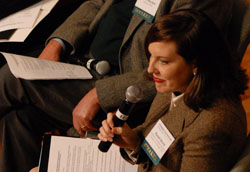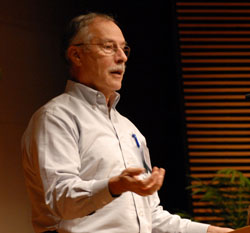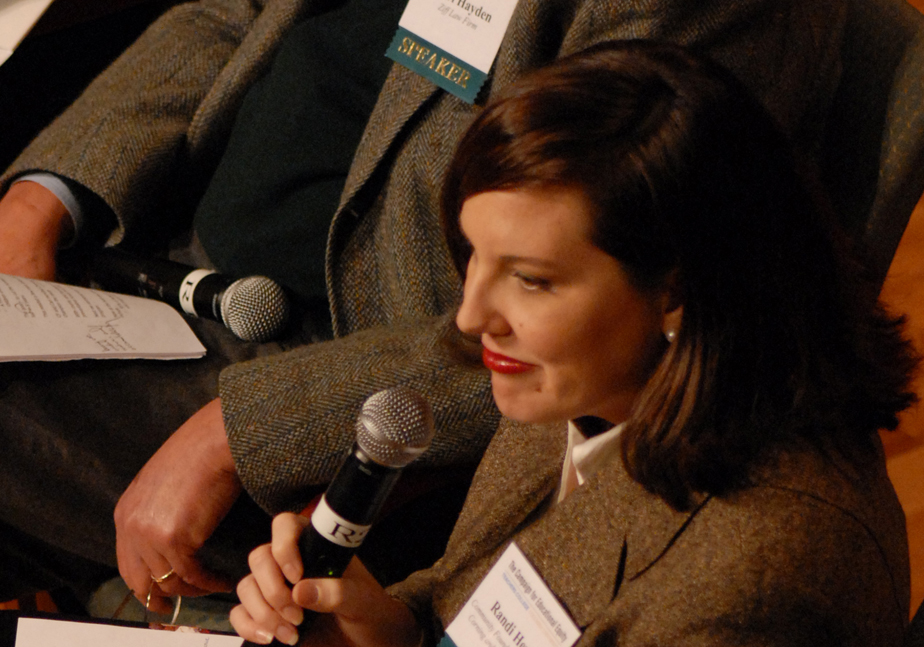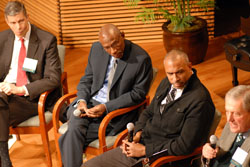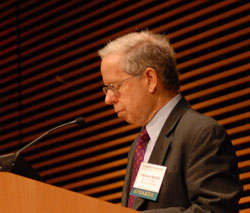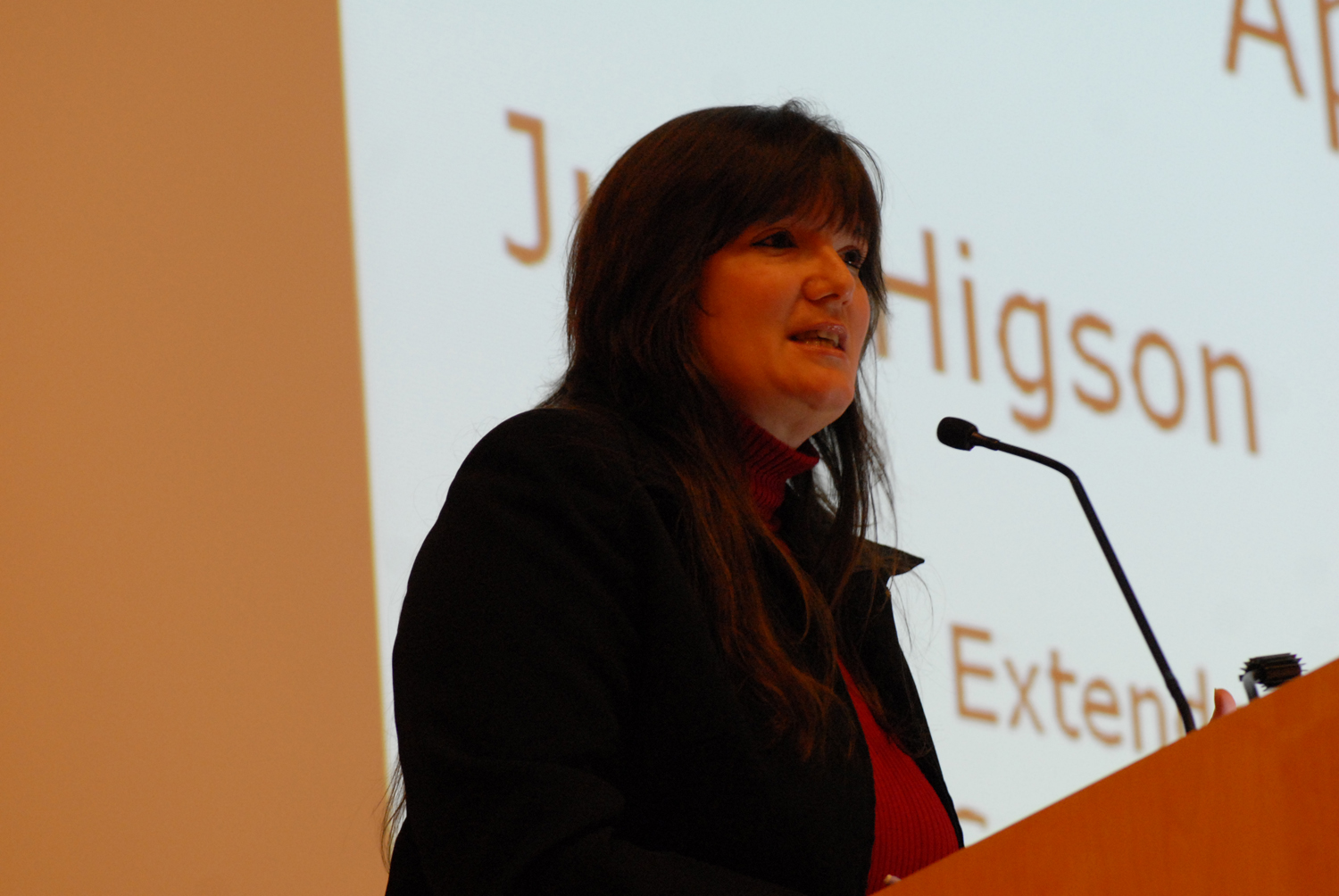Thinking Big About How to Close the Gap
Journalists tend to be cynics, but when Paul Tough talks about the Harlem Children’s Zone (HCZ)—the massive effort to provide educational, social and community support services to more than 7,400 children and 4,100 adults in a 100-square-block area of central Harlem—he leaves no doubt he’s a believer.
“My own journalistic investigation into the questions of poverty and education started a little more than five years ago, not far from here, when I first visited [HCZ Founder] Geoffrey Canada,” Tough, an editor at The New York Times Magazine, told an audience at Teachers College’s fourth annual Symposium on Education Equity in November. “By the end of our first conversation, I knew I wanted to write an article about Geoff’s work, and by the time that article came out in The New York Times Magazine in 2004, I knew I wanted to go further and write a book.”
Tough, author of the recently published Whatever It Takes:Geoffrey Canada’s Quest to Change Harlem and America, concluded that, “a true solution to the problem of underachievement in inner-city schools is going to require more nurturing families and safer neighborhoods, as well as better teachers and more accountable schools. It’s not only possible to fix both problems at the same time, it’s essential.”
Those sentiments stood as the near-consensus view of the large cast of researchers, educators and policymakers who spoke at the two-day TC symposium titled, “Comprehensive Educational Equity: Overcoming the Socioeconomic Barriers to School Success.”
Michael A. Rebell, Executive Director of TC’s Campaign for Educational Equity, which organized and hosted the symposium, argued that access for children and families to what he calls “comprehensive educational equity”—in essence, the range of services outlined by Tough—should be viewed as a moral, statutory and constitutional right.
“This is how we bring about social change,” Rebell said. “I think what we’ve got to do is establish a political platform and a legal platform that says we can no longer have limited, sporadic and unstable services in these areas. We’ve got to have a right to comprehensive educational opportunity.”
Rebell announced that he is working to form a legislative campaign to provide necessary comprehensive resources and services on “a stable, statutory basis” to all children in
Meanwhile, several researchers at the symposium documented existing gaps in specific areas of comprehensive equity and outlined current or future interventions that could make a difference in educational outcomes.
“Healthier students make better learners,” said TC Richard March Hoe Professor of Health Education Charles Basch. “Yet health issues have mostly neglected in school reform issues. But we now have a track record of programs and policies that have been demonstrated to favorably influence these factors and help reduce the achievement gap.”
Basch identified six health disparities—vision, asthma, teen pregnancy, aggression and violence, physical activity and breakfast—that disproportionately affect inner-city youth and negatively affect their educational achievement. For example, during 2001 to 2003, annual prevalence for asthma for black children ages 5 to 14 was 45 percent higher than for whites, as were asthma attacks. Asthma is highly correlated with school absenteeism and also with disturbed sleep, which has a major impact on school performance. Teen pregnancy rates are also far higher for black and Hispanic females ages 15 to 17 than for whites. The education impact is clear: teen mothers are 10 to 12 percent less likely to complete high school and 14 to 29 percent less likely to attend college than their female peers.
Even small reductions in the rate of non-marital teen births would have “substantial effects on the numbers of children living in poverty,” Basch said.
TC faculty member Jeanne Brooks-Gunn informed the audience that only 13 percent of low-income youth participate in after-school programs, compared to 20 percent of youth from the highest income bracket. If the percent of participation among low-income youth were to rise to 100 percent, said Brooks-Gunn, it could decrease the achievement gap by four to five percentage points.
“Even population-wide participation in after-school programs among poor youth is highly unlikely to completely eliminate existing achievement gaps, but it may be an important part of a multifaceted approach toward achieving this goal,” Brooks-Gunn said.
And TC’s Sharon Lynn Kagan, noting the wealth of data showing that pre-K education can improve children’s subsequent school performance and life chances, applauded the fact that “a movement toward universalizing early learning services for all prekindergarten children is taking root in the nation.” But, Kagan said, access to quality pre-K programs is income-stratified in the
What’s the price tag for providing access to such services to the children who need them most? Richard Rothstein, a research associate at the Economic Policy Institute and The Campaign for Educational Equity, presented research demonstrating that a comprehensive program of pre-natal care, parent education, literacy support, health care and teacher salary incentives could be provided to 1 million of the nation’s neediest children at a cost of $15,000 annually per child. By spending that sum, Rothstein said, “the could substantially narrow its education achievement gap” and achieve significant savings down the road in health care, crime, welfare, worker productivity and tax revenue.
Or, as Geoffrey Canada himself put it during an afternoon session at which he shared the stage with Arne Duncan, Chief Executive Officer of Chicago Public Schools, and Pedro Noguera, Professor of Teaching and Learning at New York University’s Steinhardt School: “It’s more expensive and more difficult the longer we wait, but the price never approaches the price we pay when we lock kids up.”
The recent election to the U.S. Presidency of Barack Obama—whom Teachers College President Susan Fuhrman described as “a strong believer in education and its power to transform lives”—was taken as a sign of hope by many at the symposium that the ideas under discussion at the event could eventually be acted on. Indeed, as Fuhrman noted, during the recent campaign, Obama pledged to create 20 “Promise Neighborhoods” modeled after the Harlem Children’s Zone, in cities across
“This is in many ways a propitious moment to consider the findings and proposals that will be put forth here today,” Fuhrman said. “Clearly, intervening, on a mass scale, to provide such services and programs is not something that can happen overnight. It will take years, and the twin challenges it poses of devising programs that work and mobilizing the political will to support them, are equally daunting.”
She added that “the bottom line is that has been wrestling, since its beginnings, with the question of how to enable all children to receive an education that equips them to become full and productive citizens in our society. It may be that we have now reached a point in our history when, to paraphrase Sherlock Holmes, having eliminated the impossible, we are ready to recognize that what we are left with, however seemingly improbable, just might be the solution.”
Nevertheless, the reality of the country’s current economic crisis hovered like a dark cloud over the Equity Symposium’s ambitious agenda.
New York Governor David Paterson, in a videotaped address, pledged his ideological support for educational equity and acknowledged the need for additional resources to help disadvantaged students. However, he said that New York’s current $1.5 billion budget deficit—a figure he projected to balloon exponentially over the next few years—was forcing him to take the harsh step of cutting education spending at mid-year, as governors in some other states also are doing.
Still, in remarks at a special dinner for symposium participants on the evening of the first day, Chicago Schools CEO Duncan said he believed that education will remain a top priority on the national agenda, even despite the current economic outlook.
“I have a friend back in of 150 “community schools” that offer comprehensive services. “His children attend the same school I attended. We play basketball together. And whenever we have a few minutes alone, we often end up talking about education. He is a passionate believer in public education—he attributes his personal success to education—and throughout his life he has used his position to advance the cause of public education. As it turns out, my friend was just elected President of the
- To view all papers and summaries of findings presented at the Equity Symposium, visit www.tc.columbia.edu/centers/EquitySymposium/symposium08/resource.asp.
- Video of the 2008 Symposia and other Equity Campaign related events can be viewed and downloaded through Teacher College's iTunes U store front at: http://deimos.apple.com/WebObjects/Core.woa/Browse/tc.columbia.edu.1391467603.
[Requires the free iTunes software from http://www.itunes.com]
Published Monday, Dec. 15, 2008

